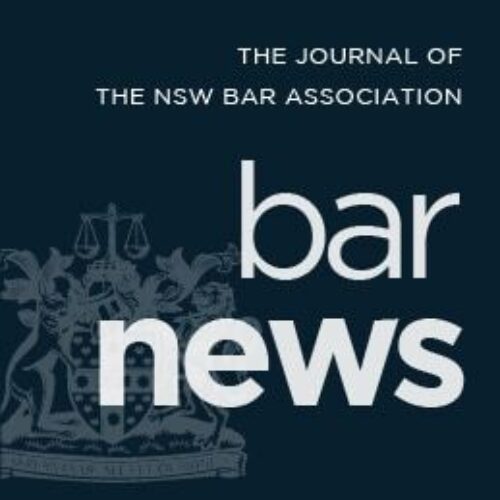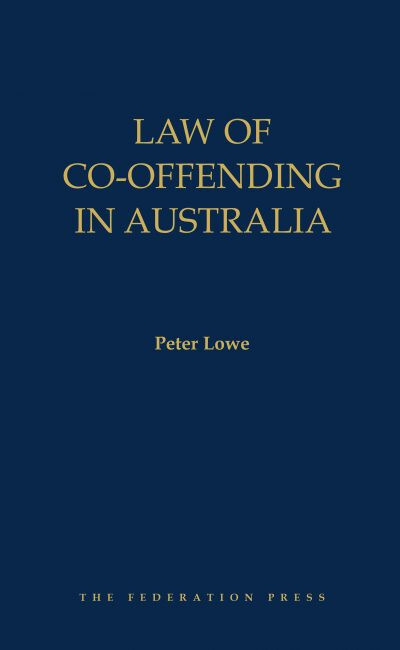- Winter 2023
- Law of Co-offending in Australia: Principles applicable to co-accused trials by Peter Lowe (The Federation Press, 2022)
Law of Co-offending in Australia: Principles applicable to co-accused trials by Peter Lowe (The Federation Press, 2022)

Generally there are strong reasons of principle and public policy why joint offences should be tried jointly: Webb v The Queen (1994) 181 CLR 41 at 88, 89, 56.
It has long been recognised that those who are charged with an offence allegedly committed jointly, such as the classic case of alleged robbers and a get-away driver, should generally be tried together. There are many ways in which joint criminal liability may arise; conspiracy, joint criminal enterprise, accessories are examples.
The reasons for a joint trial may be strengthened where each of two or more co-accused deploy a ‘cut-throat’ defence or the defence of one accused is that he or she was acting under the positive duress of the other. The fact that one accused desires to throw blame on another suggests the difficulty which could arise if separate trials are granted, enabling each accused to give evidence blaming the other without any denial or contradictor and potentially resulting in inconsistent verdicts. The interests of justice are not confined to the interests of the accused and acquittals in such circumstances may represent a miscarriage of justice. A joint trial seeks to avoid such outcomes.
But joint trials themselves raise difficulties, some of which cannot be foreseen at the outset, in maintaining a balance of fairness in the scales, not only as between the prosecution and accused, but also as between accused persons. The practical, procedural and legal aspects of trying two accused persons jointly give rise to some of the more challenging problems encountered in criminal law.

In the Law of Co-offending in Australia, Peter Lowe’s starting point is the overriding concern that trial fairness is the foundation stone on which the Australian criminal justice process rests, from which he explores the special challenges when viewed through the lens of a trial of multiple accused.
The focus of the Law of Co-offending is how each Australian jurisdiction deals with issues affecting co-accused under common law and under statute. The book is purposed for practitioners of criminal law, prosecution and defence, as well as the judiciary.
Lowe steps through the practical application of rules of evidence and procedure, with all the particular considerations that arise in a joint trial of multiple accused. His professional balance, having himself both prosecuted and defended, is ideal for presentation of the issues. These include the ins and outs of forensic decisions such as whether and how to make an application for a separate trial. He deals with the various issues that commonly arise in any trial but which are made complex by the multiple accused. These include competence and compellability, admissibility of out of court statements of co-accused, reliance on admissions, voir dire procedures, and editing of a co-accused police interview at the instigation of an accused, to name only a few.
Lowe also devotes considerable energy to exploring particular trial applications in the context of a trial with multiple accused, including no case submissions, directed verdicts, changes of plea. Closing addresses, and the scope of permissible comment by one accused on the case of a co-accused, are two aspects where practitioners will benefit from Lowe’s insights.
The book is a practical and comprehensive account of the law of co-offending. Throughout, Lowe navigates fine lines in the balance of interests when co-accused are jointly tried. It has day-to-day utility to practitioners in the various Australian jurisdictions, by identifying and explaining the rules, with accessible clarity, which apply in each place and the permutations on how they work.
Lowe notes that there is one issue which the reader should be aware may impact the book, which was the application for special leave filed by McNamara from the judgment of Rogerson & McNamara v R [2021] NSWCCA 160; 290 A Crim R 239. That application concerned the operation of s 135 of the Evidence Act 1995 (NSW), common to the uniform evidence laws in Australia, in a joint trial of accused. Subsequent to the Law of Co-offending in Australia going to print, special leave was granted and the appeal was heard on 16 May 2023. Judgment in that case may give all the more reason for a second edition. BN
